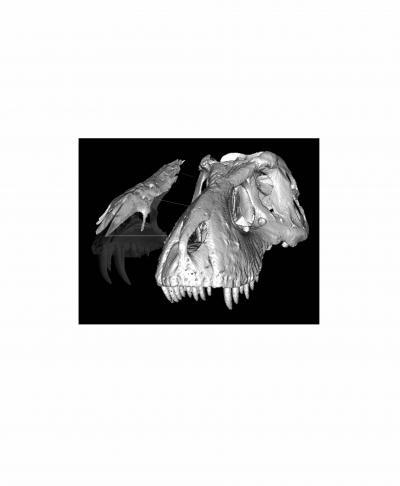New evidence may help explain the brute strength of the tyrannosaurid, says a University of Alberta researcher whose finding demonstrates how a fused nasal bone helped turn the animal into a "zoological superweapon."
"Fused, arch-like nasal bones are a unique feature of tyrannosaurids," said Dr. Eric Snively, a post doctoral research fellow at the University of Alberta. "This adaptation, for instance, was keeping the T. rexes from breaking their own skull while breaking the bones of their prey." Credit: University of Alberta
Credit: University of Alberta
Snively and co-authors, number-crunching physicist Donald Henderson from the Royal Tyrrell Museum of Palaeontology and Doug Phillips from the University of Calgary, compared the skulls and teeth of a number of tyrannosaurids to non-tyrannosaurids. In one of the first studies that looked at the structural mechanics of dinosaur skulls, the scientists used CT scans to investigate such factors as teeth bending strength and nasal and cranium strength. The research is published in the journal Acta Palaeontologica Polonica.
Tyrannosaurids differ from other dinosaurs in the great robustness of their teeth and skulls, enlarged areas for attachment and expansion of jaw muscles and the consequent ability to bite deeply in the bone.
Snively's team found that fused tyrannosaurid nasals were stronger than unfused carnosaur nasals. This extensive fusion increased the strength of such dinosaurs as the T. rex and helped them apply powerful bites that could splinter bone. With other carnivorous dinosaurs, says Snively, their skull bones might shear apart slightly when they chomp down on other animals. "With tyrannosaurs, all the bite force was delivered to the prey," he said. "The T. rex especially had a very strong skull and jaw muscles that would turn it into a zoological superweapon.
A medium-sized T. rex had even more skull strength than a larger carnivorous creature, such as the Carcharadontosaurus saharicus, with a head nearly one and a half times as long. T. rex's neck power was similarly staggering. For instance, in a split second, a T. rex could toss its head at a 45 degree angle and throw a 50kg person five metres in the air. And that's with conservative estimates of the creature's muscle force, says Snively. "We kept the muscle numbers down because we thought they couldn't possibly be that powerful, but Tyrrell museum colleagues showed that a T. rex's lower jaw could apply 200,000 newtons of force—that's like lifting a semi-trailer," he said. "All of the T. rex's features came together to give it the strongest bite of any land animal. The T. rex just blows everyone out of the water when it comes to strength.
"The fused nasal bones had been observed before, but no one but us and Emily Rayfield of Bristol hypothesized that the fusion enhanced the skull strength. Now we know it did."
Source: University of Alberta